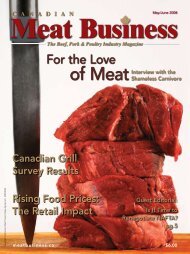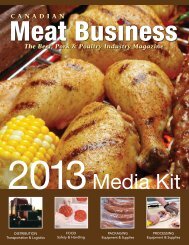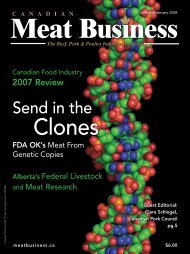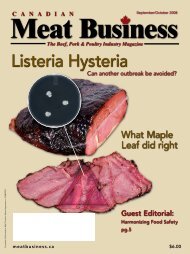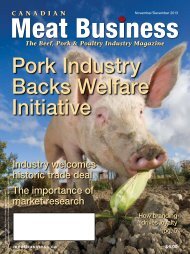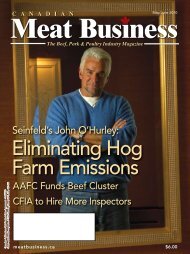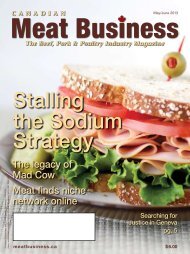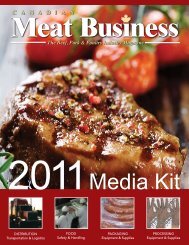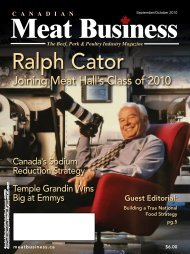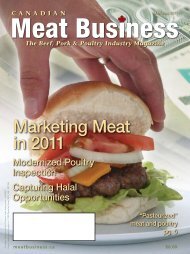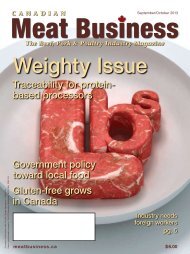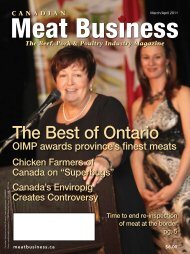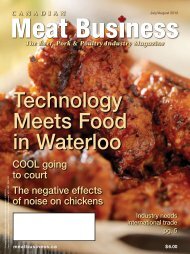Barbecue Secrets
Barbecue Secrets - Canadian Meat Business
Barbecue Secrets - Canadian Meat Business
You also want an ePaper? Increase the reach of your titles
YUMPU automatically turns print PDFs into web optimized ePapers that Google loves.
May/June 2009<br />
Just in time for summer<br />
<strong>Barbecue</strong> <strong>Secrets</strong><br />
Canadian Publications Mail Product Sales Agreement 41689029<br />
Taking the “swine” out<br />
of H1N1 Influenza<br />
Guest Editorial:<br />
Jim Laws,<br />
Canadian Meat Council<br />
pg.5<br />
meatbusiness.ca $6.00
Volume 8, Number 3 May/June 2009<br />
5 Guest Editorial<br />
by Jim Laws<br />
6 Rockin’ in the BBQ World: Rockin’ Ronnie’s <strong>Barbecue</strong> <strong>Secrets</strong><br />
by Alan MacKenzie<br />
6<br />
8 Canadian Cattle’s Roll in Caring for a Sustainable Earth<br />
10 Canadian Meat Council Annual Conference / PACKEX<br />
Toronto 2009<br />
12 Taking the “Swine” Out of H1N1 Influenza<br />
by Alan MacKenzie<br />
14 Assembly Line<br />
16 The Five Steps to Good Governance<br />
by Wayne Gelb<br />
18 Cross Country News<br />
20 The Kitchen is Open<br />
by David Rizzo<br />
23 Events Calendar<br />
24 Industry Roundup<br />
26 Be a Fly on the Wall in Your Own Facility<br />
by Bill Melville<br />
12<br />
30 Meat Industry Business Watch<br />
by James Sbrolla<br />
20<br />
10<br />
meatbusiness.ca<br />
May/June 2009 Canadian Meat Business
| Guest Editorial |<br />
May/June 2009 Volume 8 Number 3<br />
PUBLISHER<br />
Ray Blumenfeld<br />
ray@meatbusiness.ca<br />
The need for a Canada-U.S.<br />
food safety authority<br />
EXECUTIVE EDITOR<br />
Alan MacKenzie<br />
alan@meatbusiness.ca<br />
CONTRIBUTING WRITERS<br />
Jim Laws, Wayne Gelb, David Rizzo,<br />
Bill Melville, James Sbrolla<br />
CREATIVE DIRECTOR<br />
Krista Kline<br />
FINANCE<br />
Jerry Butler<br />
Canadian Meat Business is published<br />
six times a year by We Communications West Inc.<br />
COMMUNICATIONS WEST INC.<br />
We Communications West Inc.<br />
7-1080 Waverley Street<br />
Winnipeg, MB, Canada R3T 5S4<br />
Phone: 204.985.9502 Fax: 204.582.9800<br />
Toll Free: 1.800.344.7055<br />
E-mail: publishing@meatbusiness.ca<br />
Website: www.meatbusiness.ca<br />
Canadian Meat Business subscriptions are<br />
available for $28.00/year or $46.00/two years<br />
and includes the annual Buyers Guide issue.<br />
©2009 We Communications West Inc.<br />
All rights reserved.<br />
The contents of this publication may not be<br />
reproduced by any means in whole or in part,<br />
without prior written consent from the publisher.<br />
Printed in Canada.<br />
ISSN 1715-6726<br />
Cover photo: John Sinal<br />
T<br />
he Canadian Meat Council<br />
is now entering its 90th year<br />
of representing Canada’s<br />
federally inspected meat processors.<br />
And we’ve just returned from our 89th<br />
annual conference – this year held in<br />
Montreal. Just like last year, we reported<br />
that our Canadian meat processing<br />
industry is facing incredible challenges.<br />
But, this time, the challenges have all<br />
changed.<br />
What a difference a<br />
year makes<br />
Last year, a strong Canadian dollar,<br />
record high oil and feed grain prices<br />
and labour shortages were cutting<br />
into profitability. This year the recent<br />
H1N1 flu virus that has traumatized<br />
our pork sector, the U.S. mandatory<br />
country of origin labelling, new<br />
listeria control measures and the<br />
independent investigation along with<br />
the Subcommittee on Food Safety at<br />
the House of Commons are all top<br />
of mind.<br />
You will all recall the incredible<br />
political events of last year. Prime<br />
Minister Stephen Harper called for<br />
an independent investigation into the<br />
listeriosis event. A general election<br />
was then called and government<br />
officials went silent – including those<br />
from the CFIA and from the Public<br />
Health Agency of Canada. Once<br />
again, Canada elected a Conservative<br />
minority government. With calls for<br />
a full-blown public inquiry, and other<br />
political issues threatening to topple<br />
the government, our prime minister<br />
sought and received a rarely used<br />
prorogation of parliament granted by<br />
our Queen’s representative in Canada<br />
– Governor General Michaelle Jean.<br />
A gruelling and lengthy election<br />
campaign south of the border and a<br />
historic inauguration on Jan. 20, 2009,<br />
gave the U.S. its first African-American<br />
president. Since then President Obama<br />
has set his country on an ambitious<br />
plan with many large plans for reform.<br />
Canada’s prime minister, saddled with<br />
a minority government and a recession,<br />
seems to have no grand plans such as a<br />
new national high-speed railway system<br />
or a national electric power grid.<br />
Let’s offer them something big. Let’s<br />
tell them that we really believe that with<br />
these challenging economic times, we<br />
need to work more closely together.<br />
Let’s do what the many countries of<br />
Europe have done – agree on a common<br />
food safety system. Surely, if they can<br />
do it, we can do it. We’ve already seen<br />
how the misfortunes of one company<br />
in Canada on listeria control affect<br />
the entire industry, and now lately the<br />
new H1N1 virus in Mexico affected<br />
our entire North American industry.<br />
We’ve seen what happens in Canada<br />
when salmonella is traced to a peanut<br />
processor in the United States.<br />
Food safety systems<br />
With the new Obama administration<br />
now just past its 100 days, and Chrysler<br />
and GM seemingly put on life support<br />
by both the U.S. and Canadian<br />
governments, both our countries are<br />
turning their attention to their food<br />
safety systems.<br />
The Europeans have addressed<br />
their challenges with the creation of a<br />
European Food Safety Authority and<br />
their common economic union that<br />
allows for the freedom of exchange of<br />
goods and people travel without the<br />
need for border inspection between<br />
each country.<br />
Already, the North American Free<br />
Trade Agreement has helped to triple<br />
trade since 1993 among our three<br />
countries to a projected $1 trillion in<br />
2008. We can do a lot better.<br />
Our differences should be set aside<br />
and the strengths of our industry built<br />
on to compete in an ever competitive<br />
world. With the U.S. always ahead of us<br />
on access to new antimicrobial agents<br />
and interventions, and out-competing<br />
us on more favourable meat inspection<br />
fees and specified risk material<br />
regulations, it’s time we push for a new<br />
deal that sets common food safety rules<br />
for both of our countries.<br />
Jim Laws is the executive director of the<br />
Canadian Meat Council.<br />
meatbusiness.ca<br />
May/June 2009 Canadian Meat Business
Photo: John Sinal<br />
Photo: Whitecap Books<br />
Rockin’ in the BBQ World<br />
Vancouver’s Rockin’ Ronnie shares his <strong>Barbecue</strong> <strong>Secrets</strong> in an<br />
all-encompassing new cookbook.<br />
By Alan MacKenzie<br />
North Vancouver-based Rockin’<br />
Ronnie Shewchuck is so<br />
obsessed with outdoor cooking<br />
that he calls himself a “barbecue<br />
evangelist” – and his new cookbook may<br />
just be “the bible” for barbecue fans<br />
everywhere.<br />
Published by Vancouver-based<br />
cookbook specialists Whitecap Books,<br />
<strong>Barbecue</strong> <strong>Secrets</strong> Deluxe! is Shewchuck’s third<br />
book, a combination of his first two titles<br />
– <strong>Barbecue</strong> <strong>Secrets</strong> and Planking <strong>Secrets</strong> – that<br />
brings together the best of both with new<br />
photos, information and recipes. With<br />
over 200 recipes in total, charts, diagrams<br />
and entertaining extras, the book is sure<br />
to be a hit with everyone from the average<br />
backyard griller to the up-and-coming<br />
professional.<br />
With passion Shewchuck details the<br />
difference between grilling (what we do<br />
with our propane or charcoal grills at<br />
home) and the slow-cooking tradition<br />
Canadian Meat Business May/June 2009<br />
of southern-style barbecue – complete<br />
with diagrams of how to perform both<br />
methods properly. He also shows that<br />
plank-cooking can be used for much more<br />
than just salmon.<br />
But <strong>Barbecue</strong> <strong>Secrets</strong> Deluxe! is more<br />
than just a cookbook – it’s a celebration<br />
of barbecue as a lifestyle. It’s an allencompassing<br />
guide, that goes beyond<br />
recipes and tells readers what beverages<br />
and music will go best with their barbecue<br />
– not surprisingly beer and wine and<br />
country and classic rock top the lists, but<br />
Shewchuck gets much more specific with<br />
drink recipes and sample playlists.<br />
Shewchuck – a communications<br />
professional by day – has been barbecuing<br />
competitively for about 15 years and his<br />
team – Rockin’ Ronnie’s Butt Shredders<br />
– has won numerous awards on the<br />
championship barbecue circuit. The<br />
group won the 2004 Canadian National<br />
<strong>Barbecue</strong> Championships and is a twotime<br />
Alberta champion. The team has<br />
also competed in the American Royal<br />
Invitational in Kansas City (the “World<br />
Series of <strong>Barbecue</strong>”), as well as the Jack<br />
Daniel’s Invitational World <strong>Barbecue</strong><br />
Championship in Lynchburg, Tennessee<br />
– considered to be the most prestigious<br />
barbecue contest in the world. According<br />
to Whitecap Books, the Butt Shredders<br />
made barbecue history in 2001 when they<br />
became the only Canadian team ever to<br />
win a U.S.-based barbecue competition<br />
in a stunning upset at the Oregon State<br />
Open <strong>Barbecue</strong> Championship.<br />
Today Shewchuck not only competes,<br />
but also teaches cooking classes, writes<br />
articles for food publications and hosts a<br />
barbecue podcast.<br />
Born in Edmonton, Shewchuck grew<br />
up watching TV chef legend Graham<br />
Kerr, the Galloping Gourmet, on CBC TV.<br />
“I think I learned the spirit of really, truly<br />
enjoying food from him.”<br />
meatbusiness.ca
“I was brought up in a very meat and<br />
potatoes culture,” he adds. “I come from<br />
a Ukrainian family where we ate the three<br />
pork groups – bacon, ham and sausage.<br />
And I was always the guy as a teenager that<br />
whenever there was a backyard barbecue,<br />
I’d be the one who brought the threeinch<br />
thick porterhouse steak and have it<br />
all marinated beforehand – and I’d insist<br />
on grilling everyone else’s meat for them.<br />
I just always loved it.”<br />
Shewchuck adds that he is delighted<br />
by changes he is seeing in the Canadian<br />
meat industry that make it easier for him<br />
to use locally grown meat in competition,<br />
noting that better quality meat has been<br />
coming on the market in the last four or<br />
five years.<br />
“I think the cholesterol fascists have<br />
finally been at least displaced by people<br />
who like meat with really excellent flavour,”<br />
he says. “I try to (use locally grown meat)<br />
whenever possible. I’m starting to see<br />
changes that I like. When I first started to<br />
compete, I would look for pork and beef<br />
that was raised in the U.S., just because it<br />
had a higher fat content and was tastier and<br />
would stand up to the long, slow cooking<br />
of barbecue. Now I try to eat locally – I<br />
certainly look for Alberta beef, I try to buy<br />
local pork here in B.C.”<br />
Classic Dadburger Deluxe Recipe<br />
Makes<br />
12–16 patties,<br />
depending on<br />
how big you<br />
like them.<br />
Burger patties<br />
• 6 lb | 2.7 kg ground beef (or combine<br />
equal amounts of ground beef and<br />
ground pork)<br />
• 1 medium onion, finely chopped<br />
• 1 head roasted garlic, cloves squeezed<br />
out and mashed with a fork<br />
• 1 Tbsp | 15 mL toasted sesame oil<br />
• 2 Tbsp | 25 mL dark soy<br />
sauce, Worcestershire sauce or<br />
a combination<br />
• 1/2 tsp | 2 mL freshly grated nutmeg<br />
• 1/4 tsp | 1 mL cayenne (or more, if<br />
you like more heat)<br />
• lots of freshly ground black pepper<br />
• 2 eggs<br />
• 1/2 cup | 125 mL cold water<br />
Fixin’s<br />
• barbecue sauce<br />
• 12–16 cheese slices (optional)<br />
• 12–16 hamburger buns<br />
Line a baking sheet with waxed paper.<br />
Gently combine the burger ingredients<br />
in a large bowl with your hands, taking<br />
care not to overwork the meat. Wet<br />
your hands in cold water before you<br />
form the mixture into chunks the size<br />
of tennis balls. Flatten them into patties,<br />
placing them on the baking sheet. Each<br />
patty will be about 1/2 lb (250 g) before<br />
cooking. Place them in the freezer for<br />
one hour to firm them up.<br />
Preheat your grill for medium direct<br />
heat. Take the burgers out of the<br />
freezer and grill them for six minutes<br />
per side, or until they are springy to the<br />
touch, glazing them on both sides with<br />
barbecue sauce. Top each patty with<br />
a slice of cheese for the last couple of<br />
minutes of cooking. Serve the burgers<br />
on buns with your favorite condiments.<br />
- excerpted from Rockin’ Ronnie Shewchuck’s<br />
<strong>Barbecue</strong> <strong>Secrets</strong> Deluxe!<br />
meatbusiness.ca<br />
May/June 2009 Canadian Meat Business
Part of the<br />
Environmental Solution<br />
Canadian cattle’s role in caring for a sustainable Earth.<br />
W<br />
hen it comes to the<br />
environment, according to<br />
cattle producers – Canadian<br />
cattle have a bum rap. Contrary to<br />
reports, Canadian livestock make only<br />
a minor contribution to Canada’s<br />
greenhouse gas (GHG) emissions<br />
and energy use. Actually, cattle<br />
play an essential role in sustainable<br />
agriculture.<br />
Canadian cattle utilize natural<br />
resources very efficiently and cattle<br />
producers continuously look for<br />
ways to increase that efficiency. Good<br />
management of Canada’s approximate<br />
21 million hectares of pastureland is<br />
one of those ways. Not only do pastures<br />
support food production, but they<br />
provide wildlife habitat and serve an<br />
important role in GHG reductions. In<br />
some cases, pastureland stores carbon<br />
more efficiently than trees.<br />
Pastures can exist where our food<br />
crops can’t – on land that is too steep or<br />
cold or inaccessible to farm machinery.<br />
Pasture grasses play a significant role<br />
in feeding us. In Canada, since nearly<br />
one third of Canada’s agricultural<br />
land is unsuitable for crop production,<br />
utilizing it as pasture to raise cattle<br />
enables this land to still contribute to<br />
food production.<br />
More environmentally friendly<br />
than most other forms of producing<br />
food, properly managed cattle pasture<br />
lands control erosion and enrich the<br />
soil. Planted grasses are often used<br />
to rehabilitate soils where crops have<br />
grown. It is precisely because of these<br />
Better management<br />
practices have lowered<br />
the number of cattle<br />
required to produce<br />
the high-quality protein<br />
consumers require.<br />
benefits and more that cattle play<br />
such a pivotal role in our food supply.<br />
Without cattle those lands would not<br />
contribute to our food supply.<br />
For nearly 20 years, producers<br />
have worked hard to reduce the<br />
environmental footprint of Canadian<br />
agriculture by implementing best<br />
management practices to improve<br />
efficiency and reduce environmental<br />
impact. These practices include<br />
improving the diets of farm animals,<br />
selectively breeding for animals that<br />
use their diets more efficiently and<br />
improving animal health – all factors<br />
that contribute to the reduction of<br />
GHG emissions. Better management<br />
practices have lowered the number<br />
of cattle required to produce the<br />
high-quality protein consumers<br />
require. In addition, as stewards of<br />
the land, many producers adopt<br />
environmental farm plans tailored to<br />
their specific operations to enhance<br />
the environmental sustainability of<br />
their operations.<br />
Meanwhile the investments made<br />
in new technologies and agricultural<br />
research will certainly yield an even<br />
more sustainable future with cattle.<br />
They play a significant part in the<br />
burgeoning biogas industry; making<br />
it possible to turn manure, already<br />
a valuable soil amendment, into a<br />
renewable source of energy.<br />
When it comes to environmentally<br />
sustainable food production, let’s<br />
Canadian Meat Business May/June 2009<br />
meatbusiness.ca
eflect on the contributions the lowly<br />
Canadian cow makes to the environment<br />
and feeding the world.<br />
Canada’s beef and cattle producers<br />
make a valuable contribution to Canada’s<br />
economy and environment. Their good<br />
management practices maintain wildlife<br />
habitat and contribute to reducing<br />
GHG. They are committed to ensuring<br />
their practices prove beneficial to the<br />
environment, their animals and operations,<br />
plus the consumer.<br />
Sustaining Canada’s<br />
agricultural land<br />
• Canada’s cattle producers manage<br />
167 million acres of native grasses for<br />
livestock and wildlife – comprising<br />
about a quarter of Canada’s total<br />
agricultural land.<br />
• These native and tame grasses play an<br />
important role in sequestering carbon<br />
in the soil, filtering water, providing<br />
habitat for wildlife and birds and<br />
providing high-quality feed for cattle.<br />
• Producers annually convert additional<br />
cultivated crop land to tame grasses.<br />
Building and maintaining<br />
native grasses<br />
• Native grasses make a significant<br />
contribution to feeding practices that<br />
reduce methane output from cattle.<br />
• Science has proved that moving cattle<br />
from pasture-to-pasture, maintains<br />
the healthy, lush green grasses which<br />
provide easy-to-digest feed for cattle.<br />
• An easy-to-digest cattle feed promotes<br />
good weight gain and reduces methane<br />
production.<br />
• With more than 90 per cent of Canada’s<br />
beef cattle production pasture-based,<br />
the added bonus to these planned<br />
grazing practices is the flourishing<br />
wildlife habitat it creates.<br />
Eat meat and sustain the<br />
environment<br />
• Eating less meat will not save the<br />
environment. In fact, it may contribute<br />
to more demands on it.<br />
• Consuming less meat protein means<br />
that to maintain a healthy diet, people<br />
must consume more vegetablebased<br />
protein. Producing that requires<br />
the cultivation of more land, which<br />
increases use of fossil fuels and<br />
fertilizer application. Unfortunately<br />
valuable wildlife habitat is lost in the<br />
process.<br />
For more information visit the Canadian<br />
Cattlemen’s Association at cattle.ca.<br />
- Staff<br />
meatbusiness.ca<br />
May/June 2009 Canadian Meat Business
Canadian Meat Council Marks 90 Years at<br />
Annual Conference<br />
T<br />
he Canadian Meat Council<br />
(CMC) held its 89th Annual<br />
Conference on May 6 to 8 at<br />
the Fairmont Queen Elizabeth Hotel in<br />
Montreal. This year’s conference also<br />
marked the 90th anniversary of the<br />
Canadian Meat Council.<br />
The conference featured the<br />
popular Product Tasting Reception<br />
on Wednesday evening, with products<br />
from the Beef Information Centre, BSA<br />
Ingredients, Delft Blue Inc/Ecolait<br />
Ltee, FPBQ – Quebec grain-fed veal,<br />
Griffith Laboratories, Hermann Laue<br />
Spice Company, Kerry Ingredients &<br />
Flavours, Olymel and Viscofan Canada.<br />
Retail and foodservice guests were in<br />
attendance at this event.<br />
Throughout the day on Thursday,<br />
speakers addressed topics in the areas<br />
of sales and marketing, operations,<br />
and technical. Popular presentations<br />
included Current Perspective on<br />
Listeria Control by Dr. Randy Huffman<br />
of Maple Leaf Foods, and Supply Chain<br />
Alliance, by Jeff Kroll of MacDonald’s<br />
Restaurants of Canada.<br />
The program on Friday included an<br />
Photo: Jim Laws<br />
analysis of the agri-food commodities<br />
by Irene Nattel from the Royal Bank<br />
of Canada; an overview of the industry<br />
by Patrick Boyle and Rod Brenneman,<br />
the president and chairman of the<br />
American Meat Institute; a parallel<br />
between history of the CMC and current<br />
issues by Jim Laws and Don Davidson,<br />
the council’s executive director and<br />
Product Tasting Reception, Beef Information Centre booth.<br />
president; and an update on Canadian<br />
Food Inspection Agency activities by<br />
Jean Lamoureux, executive director of<br />
Quebec operations.<br />
The 90th Annual Conference will be<br />
held at the Fairmont Empress Hotel in<br />
Victoria, B.C. from May 5 to 7, 2010.<br />
-staff<br />
PACKed in for ’09<br />
PACKEX Toronto 2009 confirms its status of a<br />
Canadian must attend event for all packaging and<br />
supply chain professionals.<br />
F<br />
rom May 5 to 7 Canadian Meat<br />
Business was in attendance<br />
at PACKEX Toronto 2009,<br />
Canada’s largest packaging, material<br />
handling and logistics show.<br />
The 34th edition of PACKEX<br />
Toronto was a huge success. In spite<br />
of difficult economic times, both<br />
exhibitors and visitors communicated<br />
positive feedback to organizers with<br />
comments focusing on the quality of<br />
PACKEX Toronto as an essential show<br />
for the Canadian industry.<br />
PACKEX Toronto welcomed over<br />
354 exhibitors from Canada, the United<br />
States, and overseas. This edition<br />
presented a wider selection of exhibits<br />
represented by 143 new companies.<br />
Furthermore, PACKEX Toronto was<br />
co-located for the first time ever with<br />
IPA Canada, the National Food Process<br />
Exhibition. These two co-located events<br />
provided technologies and solutions<br />
under one roof, from food production<br />
to its shipment.<br />
PACKEX Toronto 2009 welcomed<br />
7,034 attendees, showing a thriving 17<br />
per cent increase from the previous<br />
edition in 2007.<br />
- staff<br />
Paul Medeiros and Carol Zweep,<br />
Guelph Food Technology Centre<br />
Photo:s Alan MacKenzie<br />
10 Canadian Meat Business May/June 2009 meatbusiness.ca
CUSTOM SIZES!!! CUSTOM WEIGHT LOADS!!! CUSTOM DESIGNS!!!<br />
STAINLESS STEEL PROCESSING SCREENS<br />
All BEACON Screens are custom manufactured<br />
from T-304 Stainless Steel.<br />
Our Challenge, considering the increasing cost<br />
of stainless, is to design a screen to carry the<br />
maximum weight with the minimum amount<br />
of stainless. Our nearly 60 years of experience<br />
allow us to do just that.<br />
BEACON will engineer the exact Screen for your processing requirements!!!<br />
Jerky Screens<br />
V-Screens<br />
Heavy-Duty<br />
Screens<br />
Double-Frame<br />
Screens<br />
Rib Screens<br />
CALL US FOR A<br />
QUOTATION!!!<br />
BEACON also manufacturers stainless steel<br />
Trucks, Racks, Cages & Trees for all custom<br />
designed Screens, as well as designs for<br />
Smokesticks.<br />
BEACON, Inc. 12223 S. Laramie Ave, Alsip, IL 60803 (708) 544-9900 Fax (708) 544-9999<br />
www.beaconmetals.com
Photo: Agriculture and Agri-Food Canada<br />
Agriculture Minister Gerry Ritz shows support<br />
for the pork industry on Parliament Hill.<br />
Derrick Pobereznek<br />
What’s in<br />
a Name?<br />
Governments, WHO take the “swine”<br />
out of H1N1 Influenza.<br />
By Alan MacKenzie<br />
W<br />
hat difference does a name make? Millions of<br />
dollars worth of exports, if that name is “swine<br />
flu.”<br />
In late April a deadly virus with origins in Mexico that<br />
beganspreading to the United States and Canada made<br />
headlines worldwide under the name “swine flu” – even<br />
though the virus includes genetic components of human,<br />
avian and swine origin.<br />
In the days following the outbreak, countries began<br />
halting imports of North American pork because of the<br />
association with the name, despite the fact that the virus<br />
in not a foodborne illness. Ukraine – which imported $11<br />
million worth of Canadian pork last year – banned pork<br />
from Canada and several others were reportedly considering<br />
it, including the Philippines – which imported $46 million<br />
worth of Canadian pork last year.<br />
Pork groups such as the Canadian Pork Council (CPC)<br />
and the Canadian Swine Health Board (CSHB) began<br />
pressuring the federal government to follow U.S. President<br />
Barack Obama’s lead to stop using the term. The Canadian<br />
government agreed and the virus became known as H1N1<br />
influenza – however mainstream media did not follow<br />
suit, and many pork industry officials are concerned<br />
that consumers and importers will continue to make the<br />
association between the illness and pork products.<br />
“The impact will be lessened, but it will not be back to what<br />
it was,” Jacques Pomerleau, executive director of Canada<br />
Pork International, told Canadian Meat Business. “It’s a good<br />
first step, but I think the industry will have to work very hard<br />
in the next while just to rebuild that confidence.”<br />
The situation was heightened April 28 when an Alberta<br />
farmer voluntarily reported influenza-like symptoms in his<br />
herd, resulting in a quarantine and the cull of approximately<br />
500 animals on his farm. According to the CPC the cull was<br />
made on Arnold Van Ginkel’s farm to alleviate overcrowding<br />
brought on by the quarantine.<br />
The CPC said Van Ginkel is owed a debt of gratitude by<br />
the Canadian pork industry for putting the health of the<br />
industry ahead of that of his own farm. “In addition to<br />
Arnold Van Ginkel, we would like to thank Alberta Pork,<br />
Alberta Agriculture and the Canadian Food Inspection<br />
Agency for their quick and efficient handling of the<br />
impending overcrowding issue on the farm,” CPC chair<br />
Jurgen Preugschas said in a release. “Thanks are also due<br />
to Van Ginkel's neighbours and industry partners for their<br />
ongoing support of the Van Ginkel family and for respecting<br />
and protecting the privacy of the family until they were ready<br />
to be publicly identified.”<br />
Agriculture Minister Gerry Ritz stated that the<br />
government will continue to reassure Canadian consumers<br />
12 Canadian Meat Business May/June 2009 meatbusiness.ca
and international trading partners that<br />
Canadian pork is safe.<br />
“The international scientific community,<br />
including the OIE (World Organization<br />
For Animal Health) and WHO (World<br />
Health Organization), agree that H1N1<br />
Influenza A is not a food safety issue,” he<br />
said in a release. Ritz added that Canadian<br />
consumers should show support by buying<br />
more pork.<br />
Review and strengthen<br />
biosecurity<br />
CPC and CSHB have urged hog<br />
producers to review and strengthen their<br />
existing biosecurity practices:<br />
• Visitor traffic to pig barns should be<br />
minimized to essential services only,<br />
and persons recently returning from<br />
affected regions should have no contact<br />
with pigs for at least seven days.<br />
• Barn entry requirements should be<br />
enhanced with a minimum of a change<br />
of clothes and boots and a thorough<br />
hand wash. If masks are available, they<br />
should be used, with a N95 respiratory<br />
mask and gloves being the preferred<br />
choice.<br />
• Insure ventilation systems are<br />
functioning and minimize recirculation<br />
of air inside animal housing<br />
facilities.<br />
• No workers suffering “flu” like illness<br />
should contact swine, workers should<br />
not return to swine facilities until<br />
seven days after having respiratory<br />
illness. The same should apply if a<br />
farm workers household has been<br />
diagnosed with influenza.<br />
• Influenza-like symptoms could include<br />
one or more of the following, fever,<br />
cough, body aches, and sometimes<br />
vomiting and diarrhea.<br />
• Any unusual respiratory disease in<br />
pig herds should be investigated by<br />
the herd veterinarian and diagnostic<br />
samples (lung tissues and nasal swabs)<br />
from acutely ill pigs with a fever should<br />
be sent to the regional veterinary<br />
diagnostic lab.<br />
• The decision to vaccinate swine herds<br />
with existing swine vaccines should be<br />
made with your herd veterinarian.<br />
For the health of workers in contact with<br />
swine, the groups recommended:<br />
• Report any unusual respiratory disease<br />
to your doctor.<br />
• Use masks and gloves are<br />
recommended and safety goggles<br />
when necessary.<br />
• Recommend that an annual flu<br />
vaccination be discussed with<br />
their doctor as part of their health<br />
management plan.<br />
meatbusiness.ca<br />
May/June 2009 Canadian Meat Business 13
| Assembly Line |<br />
Assembly Line is an opportunity for companies to feature new products for the meat<br />
producing, processing, packaging and distribution industry. To include information about your<br />
new product e-mail alan@meatbusiness.ca.<br />
Tamper Proof Greatness in NITA’s Newest<br />
Clamshell Labeller<br />
The new Shellshock clamshell<br />
labelling system from Montrealbased<br />
Nita Labeling Equipment is<br />
configurable to handle container<br />
sizes as small as four inches wide as a<br />
large as 15.5 inches in width.<br />
The labeller provides quality,<br />
accuracy, user friendliness, HMI<br />
(touch screen) operated, servomotor<br />
driven reliability. The over<br />
the top wipe-on labeller is specially adapted to plunge deeper<br />
through the conveyor for a consistent throughput and an<br />
exceptional accurate look to your clamshell container while<br />
offering a tamper-evident seal.<br />
The product feature stainless steel and anodized aluminium<br />
construction and no proprietary electronics.<br />
With only the clamshell and tray containers in mind, this<br />
device is aimed specifically at the baking, meats, poultry,<br />
produce and confectionary industries.<br />
nitalabelingequipment.com<br />
Protecting Your Products with Sodium<br />
Acetate and Diatcetate<br />
In December 2008 Health Canada issued an Interim<br />
Marketing Authority allowing sodium diacetate and sodium<br />
acetate to be used in meat and poultry products. Bombal<br />
(Fresh Amba) – available from Malabar Super Spice Co. Ltd.<br />
– is a special blend of these ingredients designed to slow the<br />
growth of microorganisms (including listeria monocytogenes,<br />
e.coli, bacilllus cereus and staphylococcus aureus).<br />
Bombal (Fresh Amba) is a fine powder that is easy to use,<br />
dissolves quickly, can be mixed at any stage of the process, and<br />
has a low usage rate of only 0.5 per cent calculated on the total<br />
weight.<br />
The blend is designed for both sausage emulsions and cured<br />
and injected meat and poultry products. There is no reaction<br />
with other spices or ingredients. It should be added after<br />
phosphates and salt. Sodium diacetate is a free flowing source<br />
of acetic acid (organic acid), most recognizable as a granular<br />
form of vinegar.<br />
Bombal (Fresh Amba) is available in 3 kg or 22 kg bags.<br />
malabarsuperspice.com<br />
Clarion Food Grade Lubricants Available in<br />
New Convenient Size<br />
Clarion Food Grade white oil lubricants are now available to<br />
food manufacturers in a convenient five-gallon pail.<br />
Representing the leading edge of purity and performance for<br />
more than 40 years, white mineral oil base products such as Clarion<br />
Food Grade, has given food manufacturers the opportunity to<br />
use lubricants that offer the same quality performance, or better,<br />
than traditional lubricants while helping to remove the risks of<br />
contamination or recall from operations.<br />
Clarion Food Grade white mineral oils are highly refined<br />
and stabilized so that they can be used for everything from food<br />
coatings to direct use in pharmaceutical products like suntan<br />
lotions and ointments.<br />
Clarion products meet the most stringent standards of<br />
purity and performance for food processing. White oils cannot<br />
be labelled as “food grade” unless the products pass special<br />
approval tests governed by the United States Food and Drug<br />
Administration (U.S. FDA). All Clarion Food Grade products are<br />
NSF H-1 registered for use in food processing plants under the<br />
jurisdiction of the U.S. FDA.<br />
A spokesperson for the company said applications have been<br />
submitted to Canadian Food Inspection Agency (CFIA) to<br />
register the Clarion Food Grade products in Canada.<br />
With a diverse product line, Clarion offers solutions to almost<br />
any food manufacturing need. Clarion food grade greases<br />
effectively lubricate most machinery used to manufacture,<br />
process, package and store food products. High-temperature,<br />
extreme pressure water-resistant food grade greases provide<br />
excellent rust protection and oxidation inhibition – ideal in<br />
applications where the greases may accidentally come into<br />
contact with food. Synthetic food grade oils allow extended<br />
drain intervals, in many cases, lowering the lubricant cost and<br />
reducing maintenance work. All Clarion Food Grade products<br />
are available in bulk, totes, drums or pails with the recent addition<br />
of the convenient five-gallon pail.<br />
clarionlubricants.com<br />
Food Safety is a Hands-On Issue<br />
Waterford, Ont.-based Deb<br />
Canada recently launched its Food<br />
Safety Hand Hygiene program in an<br />
e-learning format.<br />
The company says that foodborne<br />
illness is most often transmitted by<br />
food workers that fail to wash their<br />
hands effectively.<br />
The program, designed to help<br />
raise standards of food safety by<br />
reducing the risk of food being cross-contaminated as a result<br />
of poor hand hygiene, covers key topics including Centre of<br />
Disease Control statistics, communicable disease prevention<br />
and proper hand-washing techniques, according to marketing<br />
manager Patrick Boshell.<br />
The program, which is based on the Deb Skin Care System, is<br />
a combination of highly effective skin care products and support<br />
activities, designed to help food manufacturers implement and<br />
maintain effective hand hygiene. A preventative intervention,<br />
14 Canadian Meat Business May/June 2009 meatbusiness.ca
it consists of a six-step approach to skin care, which includes<br />
protection, cleansing, sanitizing, restoration, education and<br />
auditing.<br />
debcanada.com<br />
FKI Logistex Offers Sortation Equipment<br />
and System Audits<br />
FKI Logistex now offers a performance audit program<br />
for its sliding shoe, linear belt and pop-up wheel sortation<br />
equipment and systems, including the UniSort product line.<br />
The audit is designed to reveal cost-efficient ways to optimize<br />
system capacity and throughput, improve equipment<br />
utilization and extend system life.<br />
Performed by a certified FKI Logistex audit engineer, audits<br />
include a complete equipment inspection and review of<br />
operational and maintenance procedures. The comprehensive<br />
service also includes a detailed audit report containing<br />
equipment drawings, performance checklists and digital<br />
photographs for technical reference. Recommendations for<br />
maintenance, upgrades or modifications are accompanied<br />
by a complete list of recommended spare parts. The audit<br />
engineer will also provide schedules for recommended<br />
future audits and preventive maintenance.<br />
fkilogistex.com<br />
Petro-Canada Launches Environmentally<br />
Friendly Lubricant Line<br />
Petro-Canada has announced its new EcoSia brand, a<br />
suite of products that possess environmentally friendly<br />
characteristics. The product offering spans a diverse range<br />
of applications and customer segments including, but not<br />
limited to, lubricants and fluids for agriculture and general<br />
manufacturing.<br />
The EcoSia line-up includes products from many of Petro-<br />
Canada’s existing brands, including, but not limited to,<br />
ENVIRON hydraulic fluids, PUREDRILL drilling mud base<br />
fluids, CALFLO specialty heat transfer fluids, select PURITY<br />
FG food grade lubricants, PURETOL white oils, select<br />
COMPRO compressor fluids, and LUMINOL electrical<br />
insulating fluids.<br />
Petro-Canada blends and packages more than 350<br />
different lubricants, specialty fluids and greases that are<br />
exported to more than 60 countries on six continents.<br />
Majority of products are manufactured from 99.9 per cent<br />
pure base oils – among the purest in the world. As the world’s<br />
largest producer of white oils and the leading supplier of<br />
factory fill automatic transmission fluids, Petro-Canada is<br />
focused on going beyond today’s standards. With more<br />
than 30 years of experience in blending Groups II and III<br />
base oils, the company delivers a diverse line of innovative<br />
lubricants to meet an ever increasing range of international<br />
specifications.<br />
lubricants.petro-canada.ca/ecosia<br />
please visit us at: www.sperlingind.com<br />
“BOSS” equipment<br />
Industry providers to the food industry for over 100 years...<br />
• Focused on food safety with enhanced production reliability.<br />
• Specializing in engineering, fabrication, installations, Beef & Pork.<br />
• BOSS provides packers with reliable efficient equipment.<br />
Sperling<br />
Industries Ltd.<br />
51 Station St, (Box 100)<br />
Sperling, MB Canada R0G 2M0<br />
1-204-626-3401 or<br />
Fax 1-204-626-3252<br />
Also:<br />
Brandon, MB<br />
1-204-729-9190<br />
2420 Z Street, Omaha, NE 68107<br />
1-402-556-4070<br />
meatbusiness.ca<br />
May/June 2009 Canadian Meat Business 15
The Five Steps to<br />
Good Governance<br />
A company’s reputation with consumers and stakeholders is<br />
important to the bottom line.<br />
By Wayne Gelb, CA<br />
A<br />
s the population becomes<br />
increasingly sensitive to social<br />
accountability, a company’s<br />
reputation is as important to the bottom<br />
line as revenue growth. Managing your<br />
company’s reputation effectively begins<br />
with strong corporate governance.<br />
While every corporate governance<br />
strategy will have its own parameters,<br />
there are five fundamental steps that<br />
every organization should consider when<br />
putting a program in place.<br />
Step 1 – Understand stakeholders<br />
Until you truly define and understand<br />
your stakeholders, you cannot create a<br />
holistic governance program for your<br />
company. Traditionally, stakeholders are<br />
thought of as the owners, investors and<br />
the board of advisors, but you also need<br />
to consider and include management,<br />
employees, suppliers, customers, lenders<br />
and the community. For those in the meat<br />
processing industry, it is also important<br />
to consider the needs of the regulatory<br />
and health and safety bodies that govern<br />
your business.<br />
Step 2 - Identify key objectives<br />
This is essential to setting the expectations<br />
of your stakeholders and encouraging<br />
ethical decision making at all levels. Start<br />
by developing a long-term strategic plan<br />
that will satisfy all identified stakeholders.<br />
Build or revisit your company’s mission<br />
statement to ensure that it encompasses<br />
attributes such as honesty, trust, integrity,<br />
openness, accountability, responsibility,<br />
mutual respect and commitment to the<br />
organization. It is also important to make<br />
sure that growth remains a key element in<br />
defining your objectives.<br />
Step 3 – Define internal control and<br />
reporting requirements<br />
This step involves two elements. The<br />
first is to review financial reporting<br />
processes and the frequency of reporting.<br />
In this current economic climate, it is<br />
advisable to accelerate your cash flow<br />
forecasting to a quarterly, maybe even<br />
monthly, basis to accommodate rapidly<br />
changing assumptions and business<br />
conditions.<br />
The second element is to monitor your<br />
working capital carefully. This includes<br />
staying on top of your receivables and<br />
proactively identifying specific customer<br />
credit issues. Keep in mind that both your<br />
financial and operational processes need<br />
to be documented and communicated so<br />
that lenders and regulators can be sure<br />
you are taking the right steps to protect<br />
your finances, your products and the<br />
future of your operation.<br />
Step 4 – Ensure your team has the<br />
right tools and resources<br />
Ultimately a company needs to be<br />
prepared to make the necessary investment<br />
to ensure that the right tools are in<br />
place to meet the corporate governance<br />
objectives. If your management team does<br />
not have the adequate training, support<br />
and technology to run the business<br />
effectively, then the owners or board of<br />
advisors cannot hold them accountable.<br />
Consider surveying the management<br />
team to identify what resources will allow<br />
them to optimize their performance<br />
and encourage them to contribute their<br />
opinions to improve the success of the<br />
company. By doing so, you will not only<br />
gain loyalty, you will also enhance and<br />
strengthen the corporate culture.<br />
Step 5 – Enforce your policies<br />
Effective governance begins with a<br />
strong company culture. It is essential to<br />
communicate regularly and effectively<br />
so that you foster a culture where team<br />
members believe in and live the corporate<br />
values and responsibilities. That means<br />
setting clear expectations and guidelines<br />
for the team, rewarding achievements and<br />
behaviours that reinforce the company’s<br />
values, as well as celebrating company<br />
successes. However, effectively managing<br />
corporate culture also means dealing<br />
swiftly with behaviours that are not in<br />
congruence with the company’s values.<br />
It is important to remember that<br />
governance is an evolving process that<br />
demands a corporate wide effort.<br />
Wayne Gelb is a partner with Fuller Landau,<br />
Toronto-based, mid-market public accounting and<br />
business advisory firm. Wayne can be reached at 416-<br />
645-6546, or by email at wgelb@fullerlandau.com.<br />
16 Canadian Meat Business May/June 2009 meatbusiness.ca
| Cross Countr y News |<br />
Saskatchewan<br />
200 Laid Off at XL Foods Moose Jaw Plant<br />
XL Foods Inc. recently laid off all 200 staff at its Moose Jaw<br />
beef plant due to a shortage of cull and fed cattle supplies.<br />
According to the company, the shortage is “unusual” and<br />
expected to abate in the coming months. The company said<br />
the plant will remain closed until September.<br />
“We regret that we have had to take such extreme action<br />
but look forward to recalling the staff and recommencing<br />
operations on or before Sept. 28, 2009,” XL co-CEO Brian<br />
Nilsson said in a release.<br />
Manitoba<br />
Governments Launch Growing Forward<br />
Programs in Manitoba<br />
The federal government and Province of Manitoba have<br />
announced details of new agricultural programs for farmers in<br />
Manitoba under the Growing Forward framework.<br />
“Farmers expect all levels of government to work together to<br />
drive Canadian agriculture and this agreement is making that<br />
happen,” federal Agriculture Minister Gerry Ritz said in a release.<br />
“Growing Forward delivers stable and bankable programs that<br />
work for farmers. The agreement we signed today will kick-start<br />
the rollout of these essential programs in Manitoba.”<br />
“This combined support for Manitoba’s diverse agriculture<br />
industry will help advance timely programs and products<br />
that will expand agricultural business opportunities,” added<br />
Manitoba Agriculture, Food and Rural Initiatives Minister<br />
Rosann Wowchuk. “As new initiatives are created throughout the<br />
province, the ripple effect of the economic benefits will provide<br />
an even more positive growth factor in the future.”<br />
Growing Forward is a national agriculture framework to<br />
coordinate federal and provincial agriculture policy. Federal,<br />
provincial, and territorial governments are delivering $1.3<br />
billion for farm families over five years. Today’s agreement with<br />
Manitoba will deliver a total of $117.5 million from the federal<br />
and provincial governments for agriculture in this province.<br />
Growing Forward programs are tailored with the flexibility<br />
to meet Manitoba’s diverse regional requirements. The<br />
Government of Canada and Province of Manitoba have worked<br />
with farmers every step of the way to develop the Growing<br />
Forward framework.<br />
In Manitoba, the Growing Forward framework supports<br />
programs to encourage innovations such as new business<br />
initiatives and value-added products that will add to agriculturalbased<br />
value chains. Other programs include enhancements to<br />
food safety systems from the farm gate to the food plate and<br />
environmental protection planning.<br />
For a complete list of Growing Forward programs in Manitoba,<br />
visit gov.mb.ca/agriculture.<br />
Ontario<br />
Maple Leaf Foods to Wait for Sale of<br />
Burlington Business<br />
Maple Leaf Foods announced it will not continue a formal<br />
sale process for its Burlington, Ont. pork processing business<br />
until possibly early next year.<br />
“The current economic conditions and credit markets have<br />
created a less than ideal environment to sell any business,”<br />
Michael Vels, chief financial officer of Maple Leaf Foods said<br />
in a release. “There is no immediate urgency to selling the<br />
Burlington business. It is an efficient and profitable business<br />
and we want to ensure we negotiate an offer that recognizes the<br />
appropriate value for the business and meets the expectations<br />
of our shareholders”<br />
The decision to sell the Burlington business resulted from<br />
the company's decision to refocus its growth in the value-added<br />
meat, meals and bakery businesses in October 2006, involving<br />
the divestiture or exit of several of its primary processing and<br />
other operations.<br />
The company said it plans to wait until markets rebound<br />
to continue the process, which it estimates will not be likely<br />
before early 2010.<br />
Guelph Woman Arrested for Tampering with<br />
Schneider’s Meat Products<br />
Guelph, Ont. police arrested 41-year-old Mastoora Qezil in<br />
March for tampering with meat products at a grocery store.<br />
The woman, a former Maple Leaf Consumer Foods<br />
employee, was charged with one count of Common Nuisance<br />
18 Canadian Meat Business May/June 2009 meatbusiness.ca
under the Criminal Code.<br />
On March 18, Guelph police entered into an investigation<br />
when it was reported that sewing needles of various lengths<br />
had been inserted into various Schneider’s meat products at<br />
the No Frills Store located on Silvercreek Parkway.<br />
Aside from the original complaint none of the items<br />
tampered with were sold to the public. In all 12 packaged<br />
products containing 13 needles had been tampered with. No<br />
one was physically injured as result.<br />
According to Maple Leaf Foods, Qezil had worked at the<br />
company’s plant in Guelph for seven years and was terminated<br />
earlier that month.<br />
“We are very pleased that the police investigation has resulted<br />
in a charge being laid,” a Maple Leaf media statement said.<br />
“We also grateful to the cooperation extended by the police<br />
and the retailer throughout the investigation.”<br />
Bona Foods<br />
Our apologies to Bona Foods. In our last issue we<br />
did not correctly identify the company as Platinum<br />
Winners at the Ontario’s Finest Meat Competition in<br />
the “Fermented Sausage” category for its Paisanella<br />
Salami. Bona Foods is a food processing company that<br />
manufactures and distributes a variety of Italian-style<br />
deli meats throughout Canada. Visit Bona Foods at<br />
bonafoods.com.<br />
Why should people go<br />
hungry while food goes<br />
to waste?<br />
Do you...<br />
Work with a perishable or non-perishable<br />
food company in the Greater Toronto Area?<br />
Want to reduce waste and save on<br />
disposal costs?<br />
Need to free up storage space?<br />
Why not donate your surplus, close-to-code or<br />
damaged packaged food to Second Harvest?<br />
To arrange a food pickup, simply call 416-408-2594<br />
or email melissad@secondharvest.ca<br />
secondharvest.ca<br />
meatbusiness.ca<br />
May/June 2009 Canadian Meat Business 19
The Kitchen<br />
is Open<br />
A new way for processors to purchase<br />
equipment.<br />
Photo: Unitherm Food Systems<br />
By David Rizzo<br />
J<br />
ust as only a fool would buy a new car without going<br />
for a test drive, food processors now find themselves<br />
adopting a similar approach when it comes to<br />
purchasing equipment for their facilities. No longer<br />
content to simply sign-off on the delivery of large<br />
ovens and chillers at their docks, and then trying to adapt the<br />
machinery to their particular process, plant managers have long<br />
sought a means to ensure, in advance, that such equipment is<br />
optimally suited for their operation.<br />
With the advent of equipment manufacturers offering fully<br />
equipped kitchens so that food producers can “kick the tires”<br />
on new equipment by visiting the manufacturers with their<br />
product in tow, better results in terms of yield and quality are<br />
now becoming the norm.<br />
The most complete examples of these kitchens allow food<br />
processors to test varying cooking and freezing options and to<br />
optimize the equipment and the process before they put down a<br />
penny. Some manufacturers even go so far as to bring in design<br />
engineers to modify the equipment to further customize the<br />
equipment to actually improve the customer’s process.<br />
In effect, this new direction allows processors to perfect their<br />
product – be it cooked or frozen, vegetable or meat – in the<br />
“showroom” so that no surprises pop up on the production<br />
floor.<br />
Henry Ford was quoted as saying, “You can have any colour<br />
you want, as long as it’s black.” It’s not too far a stretch to<br />
make a comparison with the old paradigm of purchasing food<br />
processing machinery, where processors had to purchase “off<br />
the shelf.”<br />
In such instances, the capabilities of the equipment often<br />
dictated the cooking and freezing processes, resulting in a lessthan-optimal<br />
taste and quality of the final product for the sake<br />
of high volumes that only automated machinery can deliver.<br />
But the competitive food market takes no prisoners, and<br />
processors that don’t offer the best gustatory experience to the<br />
consumer will eventually go out of business. Hence, the need to<br />
get it right the first time.<br />
This is where the shift toward equipment-testing kitchens<br />
comes in.<br />
“The future of food process machinery purchasing is<br />
going this way, where the customer can demand to go into a<br />
kitchen and actually try out their product on the machinery,”<br />
predicts David Howard, CEO of Unitherm Food Systems of<br />
Bristow, Oklahoma. “Only then can they feel confident that<br />
the equipment best serves their operational parameters and<br />
expected results.”<br />
Already recognized throughout the food processing industry<br />
for its unique heat transfer systems that maximize yields and<br />
reduce processing times, Unitherm recently joined the, as yet,<br />
20 Canadian Meat Business May/June 2009 meatbusiness.ca
Photos: Unitherm Food Systems<br />
“The future of food process machinery purchasing is going this way.”<br />
– David Howard, CEO, Unitherm Food Systems<br />
small coterie of manufacturers that feature fully equipped test<br />
kitchens.<br />
As one of the newer, more modern, iterations of manufacturerowned<br />
test kitchens, it presents a textbook example of what<br />
type of environment awaits the producers of cooked vegetables,<br />
meats and frozen foods.<br />
Upon arrival, guests get introduced to a $2.5 million, 25,000-<br />
square-foot kitchen dedicated to high-volume, high-speed, food<br />
processing. Entry begins with a true “clean room” experience,<br />
with hygienic architectural products such as stainless steel<br />
curbing, hands-free sinks and stainless steel floor drains.<br />
“Test kitchens should be set up to resemble a high-quality<br />
food factory,” explains Howard. “Here, you walk in, change into<br />
your smock and boots, and put on a hair net. Then proceed<br />
through a hand wash station. There’s also a sanitizer to scrub<br />
and wash your boots.”<br />
The food processing area itself contains $8 million worth of<br />
fully operational production machines and product handling<br />
equipment that can continuously feed as many as 10 different<br />
cooking processes. Think: steaming, blanching, broiling,<br />
baking, searing, branding, grilling and pasteurizing; convection<br />
impingement to infrared; with gas, electric or thermal oil.<br />
Cooking temps range from below boiling point all the way to<br />
1,600° F.<br />
Continued on page 22<br />
meatbusiness.ca<br />
May/June 2009 Canadian Meat Business 21
Photos: Unitherm Food Systems<br />
Specific pieces of equipment include a flame broiler/griller<br />
with a series of eight ribbon burners to speed the browning<br />
and searing of foods such as mushrooms. In the case of poultry,<br />
the searing process seals in the natural oils before entering an<br />
oven. The oven, itself, incorporates a 16-inch wide belt that<br />
spirals around the burners to the equivalent of 150 ft. of belt,<br />
all within an 8 ft. x 8 ft. footprint.<br />
No kitchen, test or otherwise, would be complete without a<br />
gas infrared oven, the most innovative of which utilize a stainless<br />
steel burner head for increased durability.<br />
Likewise, quick cooling “crusters” have attained de rigueur<br />
status for any food processing plant that produces meat or<br />
poultry logs. Round out the chilling side of the business with a<br />
spiral freezer and a continuous impingement freezer. With the<br />
inclusion of an infrared or aquaflow pasteurizer, almost every<br />
imaginable aspect of the food processing industry gets covered<br />
in today’s modern kitchen.<br />
If that’s not enough, Unitherm’s kitchen, for one, comes<br />
staffed with design engineers willing to work hand-in-hand<br />
with food processors to modify any existing machinery into a<br />
customized cooking system. An on-site 3-D modelling system<br />
speeds the process.<br />
Test drives yield success<br />
Early feedback indicates that these kitchens are proving<br />
to be quite popular among food processors. Whether fireroasting<br />
Portobello mushrooms, steaming potatoes, cooking<br />
vegetables and other ingredients for sauces and ravioli fillings<br />
or baking chicken tenders, experimenting with the equipment<br />
emboldens processors to proceed with confidence, knowing<br />
that the equipment will maximize yields, reduce processing<br />
times, increase food safety and improve the taste of final<br />
product<br />
“One food processor based in Mexico flew directly from a<br />
trade show, where we met, to our plant near Tulsa,” recalls<br />
Howard. “We supplied the green peppers that he uses in his<br />
plant, that ultimately stuffs the peppers with other ingredients.<br />
Passing them through a correctly set-up roaster blackens the<br />
outer skin, which then gets removed to leave a slim, roasted<br />
pepper. We ran the test, and they bought a machine on the<br />
spot.”<br />
Howard tells of another processor who needed to speed up<br />
the roasting of tomatoes.<br />
“He came to our kitchen loaded with tomatoes just before<br />
Christmas,” continues Howard. “We put the tomatoes in the<br />
roaster and the project was finished in 10 minutes. In-and-out;<br />
done. In this case, we could adapt the machine to fit his exact<br />
purpose, which is why it worked out so well. But we couldn’t<br />
have done it unless he was in our kitchen with his product.”<br />
Such positive outcomes get repeated in these new kitchens<br />
throughout the country, with all manner of food products and<br />
purposes. Howard recounted stories of successfully achieving a<br />
roasting rate of 7,000 lbs. per hour of red bell peppers within<br />
four hours of having the client enter the kitchen. In the case<br />
of a producer of pre-cooked ready meals – such as lasagna,<br />
macaroni and cheese and potato salad – the producer booked<br />
two-days of stay at the Unitherm location.<br />
“We’re allowing food processors to first think about, ‘How<br />
am I going to maximize the quality of my product,’ as opposed<br />
to thinking about machinery,” adds Howard.<br />
David Rizzo, D.P.M., writes technical articles for Power PR, based in<br />
Torrance, Calif. He has published two trade books, 150 technical articles,<br />
and 300 newspaper columns.<br />
22 Canadian Meat Business May/June 2009 meatbusiness.ca
events calendar<br />
May 2009<br />
27 to 28<br />
Advanced Listeria Intervention and Control<br />
Workshop<br />
Allerton Hotel, Chicago, Illinois<br />
ami.com<br />
June 2009<br />
17 to 18<br />
Food Meets Function<br />
Best Western Lamplighter Inn and<br />
Conference Centre, London, Ont.<br />
foodmeetsfunction.ca<br />
17 to 21<br />
35th Annual Canadian Association<br />
of Foodservice Professionals (CAFP)<br />
Conference<br />
Calgary, Alta.<br />
cafp.com<br />
July 2009<br />
12 to 15<br />
IAFP 2009 96th Annual Meeting<br />
Gaylord Texan Resort<br />
Grapevine, Texas<br />
foodprotection.org<br />
September 2009<br />
10 to 13<br />
NAMP 67th Annual Convention<br />
The Broadmoor Hotel, Colorado Springs,<br />
Colorado<br />
namp.com<br />
27 to 28<br />
Alberta Foodservice Show<br />
Roundup Centre / Stampede Park<br />
Calgary, Alta.<br />
crfa.ca/tradeshows/Alberta<br />
March 2010<br />
7 to 9<br />
CRFA Show<br />
Toronto, Ont.<br />
crfa.ca/tradeshows<br />
April 2010<br />
18 to 19<br />
ApEx<br />
Halifax, N.S.<br />
crfa.ca/tradeshows<br />
29 to 30<br />
BC Foodservice Expo<br />
Vancouver, B.C.<br />
crfa.ca/tradeshows<br />
Thefoodnewz is an on line events calendar created by Debra Bradshaw of Zep Food<br />
& Beverage Division. To find out more about the events listed in this magazine visit<br />
thefoodnewz.com. If you know of events not listed please email Debra directly at<br />
zeprep@rogers.com.<br />
meatbusiness.ca<br />
May/June 2009 Canadian Meat Business 23
| Industr y Roundup |<br />
Depressed Margins in Packaged Meats<br />
Overshadows Maple Leaf’s Q1<br />
Maple Leaf Foods Inc. continues to recover<br />
from last summer’s massive product recall,<br />
the company reported today in its financial<br />
results for the first quarter ended March 31,<br />
2009.<br />
Sales for the first quarter increased<br />
6.3 per cent to $1.3 billion compared<br />
to $1.2 billion last year, reflecting price increases and the<br />
benefit of favourable foreign currency changes on fresh<br />
meat sales.<br />
Earnings from operations before restructuring and other<br />
related costs and other income decreased by 4.5 per cent<br />
to $31.6 million compared to $33.1 million last year, as<br />
significant declines in packaged meat earnings were mitigated<br />
by benefits from the restructuring of pork processing and hog<br />
production operations and price increases across the bakery<br />
business.<br />
Adjusted operating earnings in the company’s meat products<br />
group declined to $11.4 million in the first quarter of 2009<br />
compared to $25.0 million last year. Margins in packaged<br />
meat products were significantly lower than last year due to<br />
the impact of volume recovery efforts following last year's<br />
product recall. The company stated that over the next several<br />
months, its management will be implementing actions to<br />
restore margins, including appropriate price action, reducing<br />
internal costs and resuming more normalized investment<br />
in promotions. In response to the economic recession,<br />
marketing and innovation activities are focused on shifting<br />
the product mix to offer consumers a greater variety of value<br />
propositions.<br />
Earnings from fresh pork operations improved significantly<br />
in the first quarter, as the benefits from double shifting the<br />
pork processing plant in Brandon, Man., the consolidation<br />
of ham boning operations and the closure of less efficient<br />
plants were realized. A weaker Canadian dollar resulted in<br />
higher sales prices for fresh pork and increased earnings from<br />
international sales.<br />
In the first quarter, the company announced that due to<br />
difficult credit markets, it has suspended actively marketing its<br />
pork processing business in Burlington, Ont. The sale process<br />
for this business is expected to resume when credit markets<br />
stabilize and an appropriate sale value can be realized. The<br />
business is profitable and contributed to cash flow and<br />
earnings for the quarter. Earnings from the company’s poultry<br />
operations were consistent with last year.<br />
Rollstock Sales Director to be “Deeply Missed”<br />
Rollstock, Inc. released the following statement regarding<br />
the death of its sales director, Craig McBee.<br />
“Craig McBee began his sales career in automatic vacuum<br />
packaging in 1979. He joined Rollstock as the director of<br />
sales in 1998 where he was instrumental in establishing the<br />
company as the industry leader in entry-level to mid-range h/<br />
f/f/s packaging equipment. Craig found more than a job at<br />
Rollstock; he found a new family and lifted it to success. He<br />
was an authority in his field and his unique, jovial personality<br />
will be deeply missed by all who knew him.”<br />
CFC’s 2009 Executive Committee<br />
The Chicken Farmers of Canada (CFC) has announced the<br />
election of its 2009 executive committee.<br />
The 15-member Board of Directors, made up of farmers<br />
and other stakeholders from the chicken industry, provides<br />
leadership on CFC’s strategic plan and mission and has chosen<br />
the following representatives:<br />
David Fuller, a farmer from Blomidon, N.S., has been reelected<br />
as CFC’s chairman – a position he has held since 1999.<br />
He has been with CFC’s board since 1996, and has been active<br />
with the Chicken Farmers of Nova Scotia for over 15 years.<br />
Fuller and his family produce 1.4 million kilograms of chicken<br />
annually in the Annapolis Valley. Three generations of Fullers<br />
have been involved at all levels of the industry.<br />
Martin Dufresne, representing the province of Quebec, was<br />
re-elected to the position of first vice-chair. Also a member<br />
of CFC’s market development committee, Dufresne farms<br />
near St. Félix-de-Valois with his wife and three children. He<br />
produces approximately 1.7 million kilograms of chicken per<br />
year on the farm started by his father in 1954. He has been<br />
farming for over 20 years and is also the chair of the Quebec<br />
provincial board, Les Éleveurs de volailles du Quèbec.<br />
Urs Kressibucher, a second-generation farmer from<br />
Beaverton, Ont., was re-elected to the CFC executive committee<br />
as second vice-chair for 2009. Since 2004, Kressibucher has<br />
participated on the CFC market development committee,<br />
the CFC food safety committee and the CFC animal care<br />
committee. Representing District 9 (Eastern Ontario) for<br />
seven years for Chicken Farmers of Ontario and serving as<br />
vice-chair of the Poultry Industry Council, Kressibucher and<br />
24 Canadian Meat Business May/June 2009 meatbusiness.ca
his family have been chicken farmers for the past 20 years.<br />
Erna Ference has been involved with poultry farming for<br />
years and has been re-elected as the member at large. As a<br />
certified management accountant and a second-generation<br />
poultry farmer, she brings a breadth of experience to the<br />
table. Married to Reg, a former CFC board member from<br />
Alberta, they have five kids between the ages of 14 and 25.<br />
Their operation produces about 1.5 million kg per year and is<br />
located in the foothills of the Rocky Mountains.<br />
CFC’s main responsibility is to ensure that Canada’s 2,800<br />
chicken farmers produce the right amount of fresh, safe, high<br />
quality chicken to meet consumer needs. CFC is proud of its<br />
role in a continuing agriculture success story and over 30<br />
years of raising the quality chicken that Canadians trust.<br />
Reiser Begins Construction of New<br />
Customer Centre<br />
Food processing and packaging equipment company<br />
Reiser has begun construction of a new state-of-the-industry<br />
Customer Center at its Canton, Massachusetts headquarters.<br />
The Customer Center – a 6,600 square foot expansion to their<br />
existing building – builds on Reiser’s commitment to work<br />
with their customers to test and develop new products and<br />
processes. It is scheduled to open in September 2009.<br />
The center will feature a customizable processing room<br />
with space to run individual machines or fully automated<br />
lines, as well as a test kitchen for preparing finished product.<br />
The facility allows product to be processed under the same<br />
conditions found in most top-of-the-line plants in the industry.<br />
It also includes modern conference rooms for meetings and<br />
training, as well as comfortable work stations for visitors.<br />
“Reiser has a long history of providing the highest levels<br />
of customer support,” John McIsaac, Reiser’s vice president<br />
of strategic business development said in a release. “Our new<br />
Customer Center is one more way that we can help processors<br />
develop the best solution for their particular application.”<br />
Reiser’s full line of processing and packaging equipment<br />
can be tested at the Customer Center, including:<br />
• Vemag – stuffers, grinders, formers, fillers, portioners,<br />
depositors, extruders, coextruders and dough dividers<br />
• Holac – dicers, slicers, and cutting equipment<br />
• AMFEC – mixers, blenders, tumblers, massagers, and<br />
macerators<br />
• Fomaco – injectors, tenderizers, brine mixers, and tanks<br />
• Seydelmann – bowl cutters and choppers, mixers,<br />
grinders, and mixing grinders<br />
• Ross – tray sealers for case-ready and modified<br />
atmosphere packaging<br />
• Repak – horizontal form/fill/seal packaging machines<br />
• Supervac – automatic vacuum chamber<br />
packaging machines<br />
Processors are invited to contact Reiser and schedule a test or<br />
demonstration. Reiser is located in Canton, Massachusetts.<br />
reiser.com<br />
meatbusiness.ca<br />
May/June 2009 Canadian Meat Business 25
Be a Fly on the Wall in<br />
By Bill Melville<br />
Your Own Facility<br />
How to understand fly habits and prevent infestations.<br />
B<br />
eef, pork, poultry, flies? Which<br />
one doesn’t belong? While the<br />
answer might be obvious, flies<br />
are more than just nuisance<br />
pests, they are a health hazard and can<br />
cause serious problems for your facility<br />
– from contamination to shutting down<br />
operations.<br />
Flies carry more than 100 pathogens<br />
and can transmit bacteria such as<br />
staphylococcus, E. coli and salmonella<br />
every time they land. More importantly,<br />
flies can cover large distances in a short<br />
amount of time so they pose a serious<br />
contamination risk to facilities.<br />
Meat processing facilities provide<br />
the right ingredients for flies – plenty<br />
of water and food. An integrated pest<br />
management (IPM) plan, however,<br />
incorporates sanitation and facility<br />
maintenance to eliminate pests’ access to<br />
these survival needs.<br />
Do your homework<br />
Ask your pest management professional<br />
to inspect your facility for evidence of flies<br />
such as breeding sites, or conditions that<br />
attract them, like available food and water<br />
sources. In order to identify what specific<br />
flies might affect your facility, your pest<br />
management professional should be<br />
trained in pest biology and behavior.<br />
For example, he or she should be able<br />
to easily identify the difference between<br />
a fruit fly and a drain fly, as fly control<br />
treatments work best when targeted<br />
toward a specific pest species or growth<br />
stage. After the inspection, consult with<br />
your pest management professional to<br />
determine the most effective prevention<br />
options.<br />
Keep a clean house<br />
Flies can pick up bacteria from breeding<br />
spots, such as in trash or on decaying<br />
matter, and pass it onto other surfaces the<br />
next time they land. Therefore, an unclean<br />
facility is fly-friendly and open to problems<br />
down the road. Establish a sanitation plan<br />
to complement your IPM program and<br />
keep flies uninterested in your facility.<br />
Set up a regular cleaning schedule and<br />
assign duties so that everyone plays a role<br />
Photo: Orkin, Inc.<br />
Install plastic strip doors to create an<br />
extra barrier against flying pests.<br />
Meat processing<br />
facilities provide the right<br />
ingredients for flies –<br />
plenty of water and food.<br />
in stringent sanitation.<br />
• Thoroughly clean all equipment on a<br />
regular basis. Make sure to clean deep<br />
into the cracks and crevices.<br />
• Keep employee break rooms free of<br />
any uncovered food or dirty dishes<br />
that might draw flies.<br />
• Wipe up spills immediately, even if it<br />
is just water. Fruit fly larvae tend to<br />
develop in moist areas or in standing<br />
water.<br />
• Line all trash cans inside your facility<br />
and keep the lids closed to reduce<br />
odors attractive to flies. Take trash out<br />
regularly, especially if it contains food<br />
waste.<br />
• Schedule a regular trash pick-up to<br />
remove the fly attraction from your<br />
property. Keep dumpsters as far<br />
from your building as possible, and<br />
then power wash and rotate them<br />
frequently.<br />
• Remove drain covers and scrub drains<br />
with a brush and an organic cleaner<br />
to prevent build-up.<br />
Create a barrier against flies<br />
Flies breed extremely quickly, so once<br />
inside your facility, two can turn into a<br />
few in a matter of days. Regularly inspect<br />
your building’s exterior to make a few<br />
improvements that can help discourage<br />
pests from ever coming inside.<br />
• Use positive airflow to push flies<br />
out rather than suck them into<br />
your building. To check if airflow is<br />
positive, hold a strip of paper under<br />
the doorway. The paper, and air,<br />
should blow out the door and away<br />
from the building.<br />
• Pay attention to lighting on the outside<br />
of your facility. Use sodium vapor<br />
lights since they are less attractive<br />
to flies than fluorescent lights. If<br />
possible, position sodium vapor lights<br />
away from the building, shining back<br />
toward the structure.<br />
• Keep doors and windows closed at<br />
all times. Weather stripping around<br />
doors and windows will close up any<br />
small cracks or crevices.<br />
• Install #16 mesh screens on windows<br />
to block even the smallest flies from<br />
getting through. Phorid flies can be as<br />
small as .03 centimeters.<br />
• Consider plastic door strips near<br />
loading zones .<br />
• Air curtains, installed above all<br />
frequently used doors, can also help<br />
to prevent fly entry. Position highspeed<br />
fans inside door frames that<br />
blow air downward to create a barrier<br />
to flying insects.<br />
Encourage your employees to work<br />
directly with your pest management<br />
professional and report sightings<br />
immediately. With a plan in place, you<br />
can take the right steps toward effective<br />
pest management and keep flies out of<br />
the picture.<br />
Bill Melville is quality assurance director for<br />
Orkin PCO Services. For more information,<br />
contact bmelville@pcocanada.com or visit<br />
orkincanada.com.<br />
26 Canadian Meat Business May/June 2009 meatbusiness.ca
| Business Spotlight |<br />
We can help you develop a range<br />
of quality materials that will make<br />
your brand and your message<br />
stand out above the rest.<br />
COMMUNICATIONS WEST INC.<br />
We have the answer!<br />
TF. 1.800.344.7055 ext.1 I P. 204.985.9516<br />
wecommunications.ca<br />
Weighing Products & Systems<br />
• Major Manufacturer of a Full Range of Industrial Scales<br />
• Built to withstand heavy wash-down & harsh chemicals<br />
Mention this Ad and get 5% additional discount off any product<br />
Tel: 800-561-9461 or 514-695-0380<br />
E-mail: sales@weigh-tronix.ca Web site: www.weigh-tronix.ca<br />
meatbusiness.ca<br />
May/June 2009 Canadian Meat Business 27
| Product Showcase |<br />
New<br />
MAINCA MG-90 HYBRID<br />
• All in one machine<br />
• Two loading positions<br />
• Bowl capacity 90 liters<br />
(up to 60 Kg./132 Lbs.)<br />
• Mincing head<br />
(Enterprise 32/Unger 98)<br />
• Single or three phase<br />
motors<br />
1-800-465-3536<br />
ALBERTA:<br />
1-888-678-9378<br />
201 DON PARK ROAD, UNIT 1, MARKHAM, ONTARIO L3R 1C2<br />
Phone: 905-470-1136 Fax: 905-470-8417<br />
E-mail: SALES@YESGROUP.CA<br />
28 Canadian Meat Business May/June 2009 meatbusiness.ca
| Product Showcase |<br />
STAINLESS STEEL TRUCKS / RACKS<br />
Let Beacon customize<br />
one of our standard Truck<br />
designs for your processing<br />
requirements. Our experts<br />
have 80 years of experience<br />
in engineering the right<br />
Truck for the right job.<br />
Whether it is a Nesting,<br />
Bacon, Sausage or Ham<br />
Rack, we will design the<br />
unit for your needs. We<br />
do not over design and<br />
add cost or under design<br />
and give our customers a<br />
Truck that will not perform.<br />
BEACON, Inc.<br />
100 S. Mannheim Road, Hillside, IL 60162<br />
Phone (708) 544-9900 Fax (708) 544-9999<br />
beaconmetals.com<br />
Graphic Design I Marketing I Publishing<br />
Writing/Editing Services I Public/Media Relations<br />
COMMUNICATIONS WEST INC.<br />
We Communications West Inc. is a successful and<br />
innovative creative design agency and<br />
publishing company.<br />
Are you looking for effective and creative ways to<br />
communicate with your clients or market your<br />
products and services?<br />
We can help you develop a range of quality materials<br />
that will make your brand and your message<br />
stand out above the rest.<br />
We have the answer!<br />
TF. 1.800.344.7055 ext.1 I P. 204.985.9516<br />
wecommunications.ca<br />
meatbusiness.ca<br />
May/June 2009 Canadian Meat Business 29
| Meat Industr y Business Watch |<br />
Stimulating Growth by<br />
Funding Innovation<br />
By James Sbrolla<br />
Ontario meat sector companies take note!<br />
T<br />
he Province of Ontario has<br />
found a new way to stimulate<br />
growth in companies<br />
embodying new technology. The<br />
Investment Accelerator Fund (IAF)<br />
is an early-stage seed fund that is<br />
managed by the Ontario Centres of<br />
Excellence (OCE). It is designed to<br />
help Ontario based start-up and earlystage<br />
technology companies bring<br />
their products and services to market.<br />
Through investment of up to $500,000,<br />
the IAF will help commercialize and<br />
bring to market technology ventures<br />
that have high potential.<br />
In addition to critical seed investment,<br />
that is often a challenge for early-stage<br />
companies to secure, the IAF also<br />
provides access to valuable services<br />
such as market research and business<br />
mentoring through the Business<br />
Mentorship and Entrepreneurship<br />
Program (www.marsdd.com).<br />
The IAF is part of the Market<br />
Readiness Program, which OCE is<br />
delivering in partnership with MaRS<br />
and the National Angel Organization.<br />
Together, these organizations provide<br />
a platform of programs and resources<br />
that entrepreneurs and innovators<br />
can access to help create successful<br />
businesses. Essentially the money<br />
comes from the province through the<br />
Ministry of Research and Innovation<br />
and is administered through the OCE.<br />
According to Shirley Speakman,<br />
investment manager of the IAF, there<br />
has been tremendous traction for this<br />
new fund. “We have had hundreds of<br />
companies apply and we have made<br />
eight investments to date. The quality<br />
and quantity of exciting companies<br />
that are commercializing in Ontario<br />
is truly amazing.” Speakman goes on<br />
to say that, “Companies are rigorously<br />
evaluated through an investment<br />
process. Knowing the challenges<br />
that start up companies face, we try<br />
to respond quickly to investment<br />
opportunities.”<br />
Eligibility<br />
The IAF is open to Ontario-based<br />
start-up or early-stage technology<br />
companies that have received no<br />
significant institutional investment<br />
and meet the following minimum<br />
requirements:<br />
• Technologies or intellectual<br />
property (IP the company intends<br />
to commercialize must have unique<br />
and protectable aspects that<br />
establish a sustainable competitive<br />
advantage);<br />
• The company must have<br />
unencumbered rights to<br />
commercialize the technology;<br />
“The quality and quantity<br />
of exciting companies<br />
that are commercializing<br />
in Ontario is truly<br />
amazing.”<br />
– Shirley Speakman, Investment<br />
Accelerator Fund<br />
• The products and services the<br />
company intends to bring to<br />
market must meet a defined<br />
market need and have a significant<br />
and sustainable advantage over<br />
competitors;<br />
• The addressable market should be<br />
at minimum $20 million;<br />
• The management team must have<br />
the appropriate skills and domain<br />
expertise or be willing to replace or<br />
augment the team if necessary;<br />
• There must be a clear and plausible<br />
path to commercialization;<br />
• Both pre-revenue and early revenue<br />
companies are eligible;<br />
• A minimum of 50 per cent of salaried<br />
employees must be based in Ontario;<br />
The terms of the funding are quite<br />
reasonable for companies that qualify.<br />
The money is invested in the form<br />
of a convertible debenture. This is a<br />
“loan” like instrument. The interest<br />
rate is prime plus one per cent, which<br />
is extremely competitive compared<br />
to other sources of venture capital.<br />
The loan is convertible into equity<br />
(at a discount) when another round<br />
of significant financing is completed.<br />
While there are no personal guarantees<br />
required, the investment is secured<br />
against certain assets of the company<br />
and the company must give up five per<br />
cent of the equity of the business to<br />
consummate the investment.<br />
The IAF investment money must be<br />
directed at specific initiatives that come<br />
from the following business activities:<br />
• Recruitment of team members<br />
• Business development<br />
• Late-stage product, process or<br />
service development<br />
• Implementation of a defined<br />
marketing or distribution strategy<br />
The IAF selection process is extremely<br />
competitive. Hundreds of companies<br />
have applied thus far and many have<br />
met the guidelines. However, meeting<br />
the eligibility requirements alone is not<br />
a guarantee that a company will receive<br />
investment. Resources are limited and<br />
only select companies will ultimately<br />
receive investment.<br />
The IAF funding program is an<br />
outstanding instrument for companies<br />
that do receive investment. It brings<br />
capital at a critical stage that may not<br />
be available from traditional sources.<br />
In these current tight financial times<br />
this opportunity should not go by<br />
unexplored.<br />
James Sbrolla is a Torontobased<br />
management consultant<br />
and can be reached at<br />
416.234.5120<br />
or sbrolla@rogers.com.<br />
30 Canadian Meat Business May/June 2009 meatbusiness.ca



